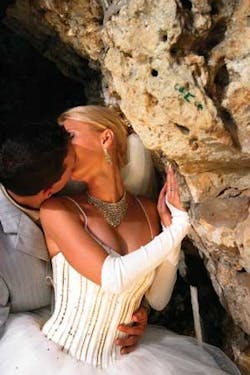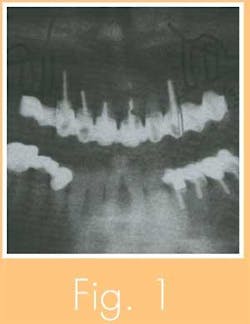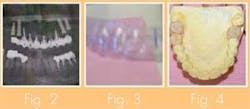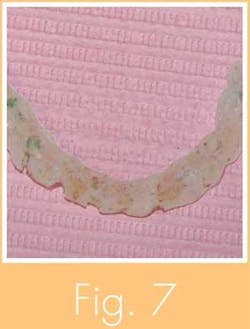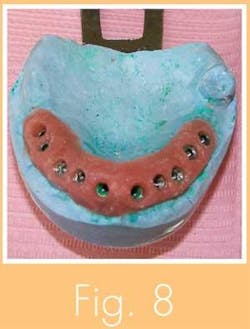Aristotle maintained that women have fewer teeth than men; although he was twice married, it never occurred to him to verify his statement by examininghis wives’ mouths.” - Bertrand Russell
By Jacqueline S. Winter, DDS
Unlike Aristotle, we dentists have looked in enough oral cavities to know the fallacy of this statement. When a patient came in for an implant consult for a failing maxillary 10-unit cantilever bridge, we expected an interim denture based on the most current treatment methods. Our esthetically concerned patient had two requests - no bone grafting or sinus lift, and no dentures.
The patient is a healthy, nonsmoking, 50-year-old, white female. She had a 10-unit cantilever bridge spanning teeth 4 through 13, with teeth 6 through 11 as abutments (see Fig. 1).
The patient was referred to oral surgeon Andrei Mark. He used the i-CAT cone beam scan to make a three-dimensional image of her bone. This aided in placing the implants and determining whether extra bone grafting would be needed because of resorption. Because immediate loading for such a large span may not be predictable, we used the two-stage approach.
Stage I-Lifecore implants were inserted in positions 4, 5, 12, and 13. A temporary bridge was made from an omnivac shell made from the original bridge and cemented on the remaining anterior teeth (see Figs. 2-4).
Stage II-Biolock silhouette implants were placed in positions 6 through 11. A new temporary was made and cemented on the posterior abutments now placed on 4, 5, 12, and 13 (see Figs. 5 and 6).
The esthetics of the old bridge were modified to include a cantilever pontic on 2, 3, and 14, and a rest on No. 1 for more support. It was important to compensate for the lip support and give a full smile line with no black triangles at the buccal corners.
When the abutments for the anterior implants were inserted six months after the initial placement, another temp was made and a pickup with transfer copings was sent to Angel Dental Lab. The lab prepared the abutments on the master model while the patient wore temporary abutments. The lab fabricated an acrylic transfer gig (see Fig. 7) and marked to assure the correct positioning of the prepared abutments in the patient’s mouth. The lab also prepared the framework for the same-visit try-in. For better gingival adaptation, we picked up the framework and poured a tissue model (see Fig. 8).
We tried in the bisque bake during the next appointment. Because the esthetics were pre-determined by the temporary, only slight shade corrections were made to give more individualized tooth definition. The final bridge, Nos. 2 through 14, was then temporarily cemented.
A challenging prosthetic aspect of this case was making up for the patient’s occlusal asymmetry by increasing the upper lip support with porcelain. In addition, we broadened her smile following the lower lip line and got rid of her “unsightly, sucked-in-cheek look,” as well as interproximal and buccal black triangles.
In conclusion, we can admire how technology helped us envision the end result with the I-CAT 3-D image. Constant communication with the lab also helped with the soft-tissue issue.
Best of all, the patient didn’t need an interim denture.
Acknowledgements
Special thanks to Dr. Andrei Mark, the oral surgeon who placed these implants, and to Angel Dental Studios for fabricating the restorative dental components.
References
Baharloo B, Textor M, Brunette DM: Substratum roughness alters the growth, area and focal adhesion of epithelial cells and their proximity to titanium surfaces. J Biomed Materials Res Vol. 74A,p12-31 2005.
Tarnow D, Elian N, Fletcher P, et al.: Vertical distance from the crest of bone to the height of interproximal papilla between adjacent implants. J Periodontol 2003;74(12):1785-1788.
Shillingburg HT, et al.: Fundamentals of Fixed Prosthodontics 3rd ed. Quintessence Publishing Co. Inc.;1997. Chicago, Ill.
Chu SJ, Derrigus A, Mielszko AJ: Fundamentals of 2004:14-16.
Preston JD: The Golden Proportion Revisited. J Esthetic Dent 1993;5(6)247-251.
Rieder CE: Use of Provisional Restorations to Develop and Achieve Esthetic Expectations. Int. J Periodontics Restorative Dent 1989;9(2):122-139.
Fradeani M: Esthetic Rehabilitation in Fixed Prosthodontics: Esthetic Analysis - A Systematic Approach to Prosthetic Treatment.1st ed. Hanover Park, Ill.; Quintessence Publ.;2004:154-263.

